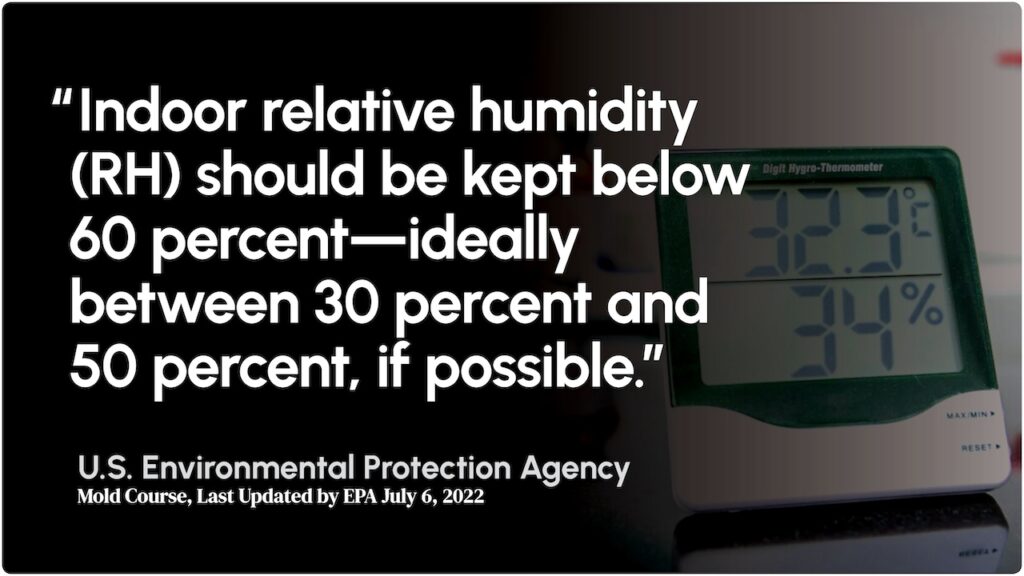
What a Hygrometer Is
A hygrometer is a device that measures and displays the humidity level, or moisture content, within a room or environment.
“Hygrometer” is derived from the Greek hygros, which means wet or moist + meter: A meter for measuring wetness or moisture.
Since mold requires moisture in order to grow, the use of a hygrometer can help occupants detect and prevent moisture levels that would cause or contribute to mold growth.
When you set up one of these inexpensive meters in a room in your home, it will measure the temperature and moisture content in that room in order to display a number that indicates how much humidity is present.
What the Numbers Mean
Your hygrometer will display this number as a percentage from 0% – 100%, though the very highest and lowest points on that scale are rarely seen.
In the image below, the top set of numbers (66.8 °F) is the temperature; the bottom set (38%) is the relative humidity level.
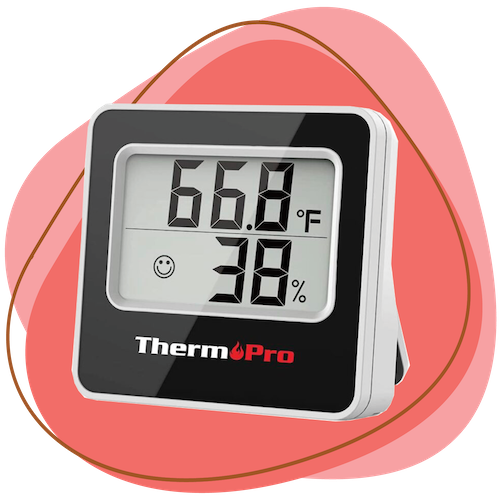
At 100%, the air in a given space is saturated with moisture, and the dew point is reached.
The higher the number on that hygrometer, the more it is screaming to alert you that mold is now or will soon be present, if the high-moisture conditions persist. [There are numerous other uses for the reading a hygrometer provides, but for our purposes: High reading = Mold alert!]
To help prevent mold growth, the relative humidity of a room or space should be kept below 60% at the highest (worst), but ideally between 30% and 50%. (U.S. Environmental Protection Agency, Mold Course).
“Keep humidity levels as low as you can—between 30% and 50%–all day long. An air conditioner or dehumidifier will help you keep the level low.”
U.S. CDC, “Basic Facts about Mold and Dampness,” August 11, 2020
Mold needs moisture to survive and it loves moist areas, small and stagnant water puddles, and soaked surfaces including particle board, bathroom tiles, shower shelves, and other surfaces, vertical or horizontal, that remain perpetually moist.
With use of a hygrometer, you can determine whether the rooms in your house are humid enough to be at risk for an outbreak of the toxic fungus.
Then, if necessary, you can take action to remedy the situation before a serious mold problem develops.
Caution: Low hygrometer readings can provide a false sense of safety
Buying and using a set of hygrometers in each of the key rooms of a house is one of the best things a homeowner or apartment resident can do to keep abreast of conditions that may contribute to mold.
One caveat is in order, however:
The humidity index of a room can read at below 60% on a hygrometer, and yet mold may still grow in parts of that room, such as where water builds up, sits on, or soaks into certain surfaces.
To avoid this potential problem, add leak detection, and water and puddle clean up and prevention to your highest priority mold prevention tasks, and scout for new leaks frequently.
That slow drip that you think you hear coming from under the sink or inside the bathroom vanity as you sit using the restroom should be inspected quickly and its source should be located and fixed!
The hygrometers you place around the house should display a relative humidity of less than 60% at all times, with 30-50% being ideal.
If your home’s ventilation is good and you maintain best practices, this should be easily accomplished.
“Best practices” include being mindful of the moisture levels in rooms where water is used, cleaning up spills quickly and fully, running ceiling fans and the air conditioner, and closing windows in bad weather. If these simple steps don’t bring a home’s humidity level down to a healthy level, you may want to hire an air conditioning specialist. It should not be necessary to have multiple dehumidifiers running in a home year-round to bring humidity down—the building’s air conditioning system should handle that—but doing so is much better than doing nothing about a high humidity level.
(Basements may be an exception—an area you may need a running dehumidifier year-round.)
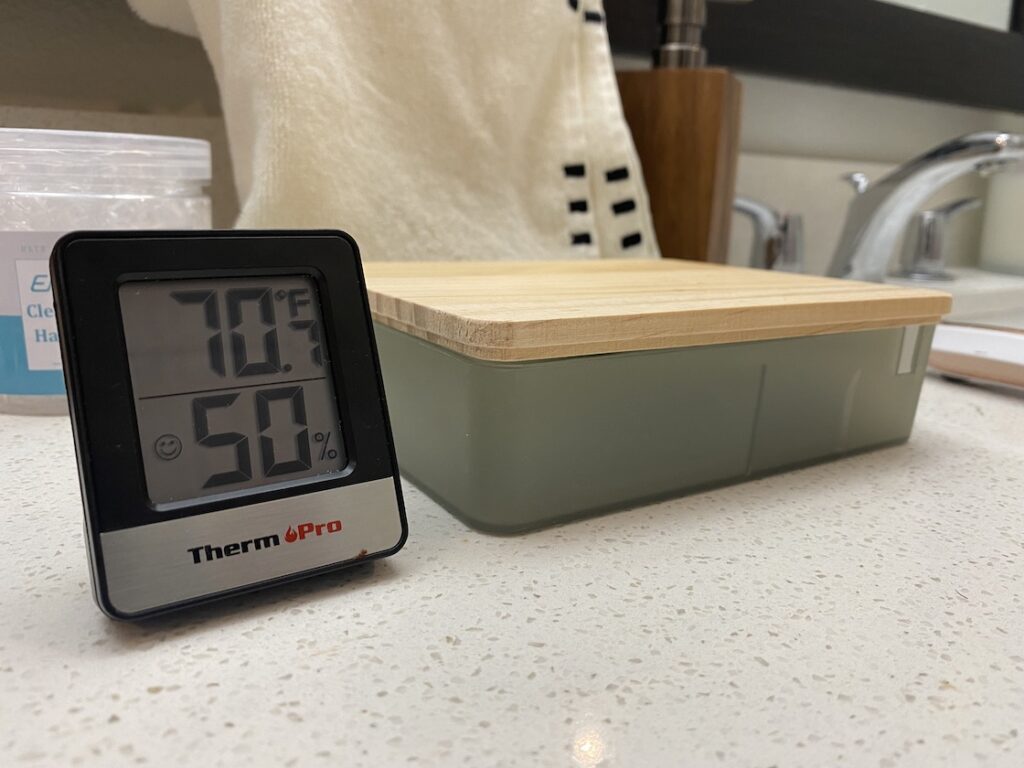
ABOVE: This inexpensive and properly working hygrometer tells us that the bathroom is 70.7 degrees Fahrenheit (70.7 °F), and that the room’s Relative Humidity is 50%, which is typically considered acceptable for mold prevention.
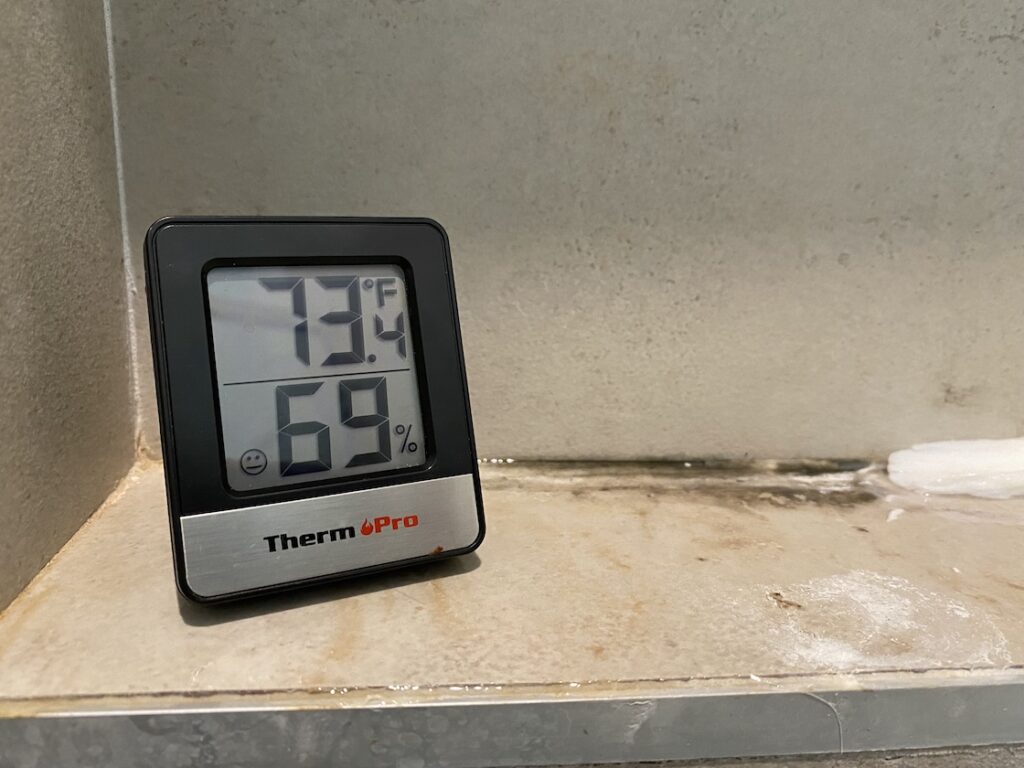
ABOVE: The same hygrometer, now moved to a shelf in the shower some seven feet away, now displays a relative humidity of 69%—too high for safety. Notice the mold to the right of the hygrometer, where shampoo bottles previously sat.
The moral of this story isn’t that hygrometers aren’t useful in mold prevention (or in detecting pro-mold-growth conditions), but that leaks and standing water affect the humidity of various parts within all rooms in your house, and that leak prevention, location, and clean up should be among the highest priorities in mold prevention.
(Don’t use a hygrometer in your shower, this was placed only for the photo.)
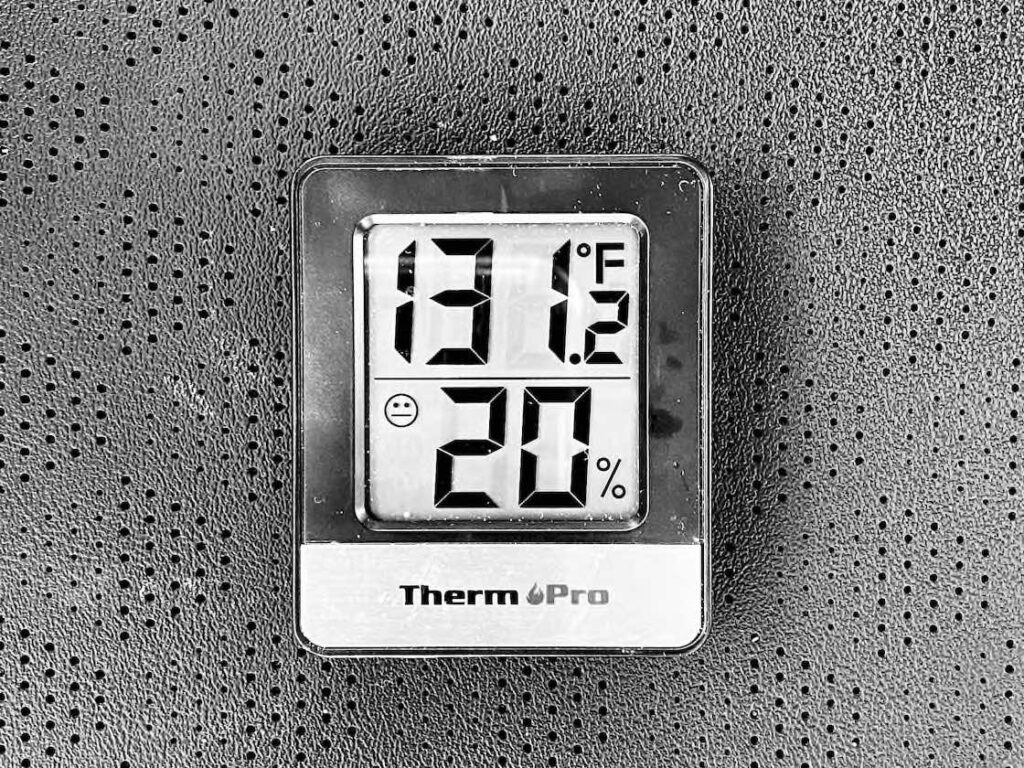
ABOVE: In this third example, our hygrometer is left inside of a vehicle (in the sun of Texas), and it tells us that the vehicle’s interior is 131 °F, with a humidity level of 20 percent!
Fantastic, right? Zero mold should be growing anywhere in the car, right? Unfortunately, no.
Half of an apple that had dropped beneath the passenger seat and was facedown on the carpet, had grown completely moldy.
Now whether this mold growth occurred overnight (perhaps when temperatures were lower and humidity was higher) or not is a fairly moot point as both temperatures and humidity levels will fluctuate in all rooms and all vehicles throughout the day.
And the point being made is merely that there is more to mold prevention than buying and using a set of hygrometers.
That said, they are still extremely important to pro-mold condition detection.
What Humidity Levels Should Be to Prevent Mold
Generally, the ideal RH level for your household is in the range of 30 to 50%. Anything above 50%, and you start to be at a risk for mold growth.
If that number climbs above 60%, you’ll want to take prompt action to reduce the humidity. It’s also worth noting that during the winter months, the RH level in your home may need to stay below 40% to prevent condensation from forming on the windows (which may in turn lead to a build up of moisture at the base of windows, and thus to mold growth).
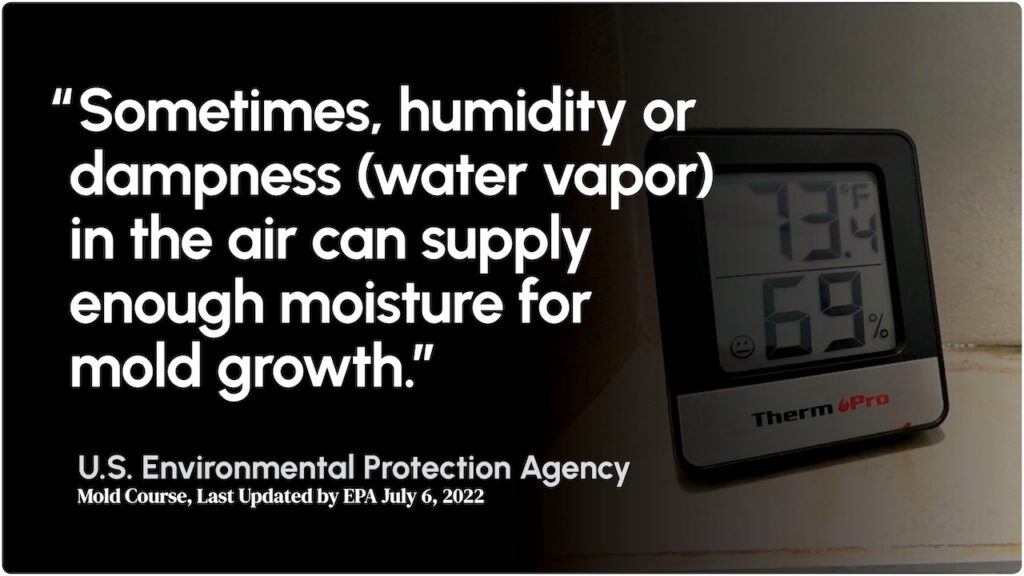
“Sometimes, humidity or dampness (water vapor) in the air can supply enough moisture for mold growth. Indoor relative humidity (RH) should be kept below 60 percent—ideally between 30 percent and 50 percent, if possible.”
U.S. EPA, Mold Course, Updated July 6, 2022
Where to Put a Hygrometer
So, if you’ve invested in a hygrometer, you’re probably wondering where you should be using it in your household. Ideally, there are several areas where monitoring the humidity level is always a good idea.
1. Bathrooms
More often than not, bathrooms are the most humid areas of a home. When you consider that they’re often small rooms with hot showers running about twice daily, it isn’t too difficult to understand why.
Plus, they aren’t always ventilated as well as they should be. The combination of that extreme humidity and frequent warmth in a small space means that bathrooms can commonly become breeding grounds for mold spores.
So, if you’re using a hygrometer to measure the humidity of your home, the bathrooms are a good starting point. Keeping the RH consistently below 40% in your bathrooms is probably an unrealistic goal, but what’s important is that you keep it below 60%. If you discover that the RH is higher than it should be, there are a few things you can do to reduce the humidity level of your bathroom.
- Run the ceiling fan more often
- Open a window to the outdoors if it isn’t raining or excessively humid
- Upgrade the ventilation system; replace the ceiling fat with a more powerful one
- Crack the door open while showering to allow the moisture to dissipate into adjacent rooms
- Wipe down bathroom walls and the shower curtain after showering
- Dry your towels outside of the bathroom
- Don’t hand wet clothing inside the bathroom to dry
2. The Kitchen
Another part of the home that’s typically very humid is the kitchen. This is primarily because water sources like the sink, refrigerator, and freezer lead to moisture and dampness around the room. When you combine that moisture with the frequently high temperatures from using the oven and stove, kitchens can become major hot spots for mold spores.
There may not be much you can do to prevent your kitchen from getting warm, but you should be able to keep the humidity level under control.
Check your home’s kitchen with a hygrometer and see if the RH level is near or above 60%. If it is, you’ll want to take measures to bring that number down. If your kitchen has a stove fan, using it more often can certainly help. Additionally, installing a more powerful ventilation system could make a massive difference in preventing all that moisture from lingering in the stagnant air. That said, the most effective option may be to invest in a dehumidifier, which will allow you to greatly reduce the RH level.
3. The Basement
Basements tend to be one of the most common household areas for mold to grow, and there are several reasons why the space below your house may be overly humid. If a pipe is leaking water, the sump pump is malfunctioning, the sewer line is clogged, or the foundation is cracked, significant amounts of moisture could be entering the basement. Then, when you consider how poor the ventilation often is down there, it’s no surprise that basements are commonly infested by mold. So, when you’re testing your home with a hygrometer, you definitely shouldn’t ignore the dank area underneath your living space.
If the RH level exceeds 50%, you should consider searching for leaks, opening any windows occasionally, and/or installing a dehumidifier. When mold starts to grow down there, it can spread and develop quickly, so getting ahead of it can save you quite a bit of stress in the long run.
4. The Attic
It would be prudent to bring your hygrometer up to your home’s attic as well. Not only are there multiple ways that moisture can find its way into the upper section of the house, but the air up there also tends to be pretty stagnant. As a result, the area is not an uncommon spot for mold to show up.
If you test the humidity in your attic and get a result of 60% or higher, you’ll want to do some detective work to figure out how so much moisture is accumulating. It may be a good starting point to have your roofing inspected, as the liquid could be seeping in through a leaky or deteriorating shingle. The high RH level could also be a result of poor attic ventilation, which is a very common problem that many homeowners encounter.
5. The Garage
Finally, if your home features a garage, you should take the time to test its humidity with your hygrometer. Whether it be due to small gaps or openings, rain or melting snow on your car, or a lack of ventilation, garages can frequently become excessively humid. In addition to increasing the risk of mold growth, a high RH level in your garage can cause your tools to become rusty and your automotive parts to become corroded. If you discover that your garage’s RH level is close to or above 60%, there are a few things you can try to get that humidity back under control before it starts to have negative impacts.
Opening the garage door will quickly correct and lower the humidity levels in it, but this is only a temporary fix. If you find your garage hygrometer reading above about 50-60% often, you will need to take additional action to prevent mold growth that could damage the books or affect the health of other items you may have stored there: Inflatable mattresses, clothing stored for future seasons, and many other organic or porous items can be affected by garage mold growth.
- Use a heater to reduce condensation during winter
- Check the status of the drainage system
- Run a dehumidifier
- Wash (and dry) your car outside of the garage if possible
- Improve the ventilation (open the door/windows occasionally or install exhaust fans)


4 Responses
Hello , just wanted to say I really like your website and have read some great articles . My child too is sensitive to mould therefore I read and research and learn as much as I can about mould prevention and remediation .
I have a Q about mould in basements. Do you know about waterproofing or water managing basement’s ? interior water management is installing a weeping tile that directs water to a sub-pump AND exterior waterproofing requires excavation of the soil around the homes outer walls and waterproofing the outer homes basements walls .
So We are looking into either water management or waterproofing a basement but not sure if interior waterproofing is the best method for prevention of future mold. Interior waterproofing involves installing a weeping tile all along the whole outer perimeter of basement floor that catches and directs any water leaks from the wall to the weeping tile then to the sub pump and outside the home . I’d like to ask you Do u think that is a good method to truly prevent mould or not ? Or is exterior waterproofing better ? We prefer exterior but unfortunately there are some challenges with exterior work on our home and interior seems to make more sense for our home, but we are not sure if it’s really a good enough fix for mould prevention . We also plan to finish the basement too with drywall and insulation and possibly cork flooring which I’ve read is mould resistant.
I’d also like to ask is there an alternative to drywall and insulation that is more so mould resistant.
Many thx
NAT
Hi Nat, Thank you and I’m so glad you’ve found this helpful. Finished basements are a pretty involved topic as I’m sure you know, and you’re asking some great questions, which I’ll do my best to answer.
I’m not sure where you live or what the weather is like there and that will be a factor. If you’ve lived there at least a year and have an idea of the weather and rain fall year round (as well as ground water conditions), you can probably establish whether your basement is a low, medium, or high risk. The more water, the more risk. So that would be rainfall, runoff, elevation, soil type, and how the house and the area around it is laid out.
Basic Answers to Your Questions:
* Exterior waterproofing is always the best option. (But is also never perfect so interior work/upkeep is also needed.)
* Concrete floors and walls are hydrophilic, so water can and will come in through them (as vapor over time if no cracks, or as liquid if there are cracks), especially so at basement level.
* The cold of a basement contributes to dampness and humidity. But, you can’t close off the “breathability” or the basement to correct that. This makes some flooring types less ideal, like carpet and wood, basically leaving tile as the best if not only option.
* Interior water/humidity control typically requires more care in a basement than anywhere else in a home. For example, basements are the only part of a home that should have a dehumidifier running basically year-round. Even if the home’s A/C is working perfectly (and is extracting moisture out of the air in other parts of the home).
* Insulation: ROXUL by ROCKWOOL is usually suggested as one of the best insulations for basements if mold concern. Spray foam not a good choice if worried about mold.
* Drywall: Instead of drywall, these two are great products: Hardie Backer Cement Board and JetBoard. So-called “moisture resistant drywall” isn’t all that great.
For flooring in a basement, putting tile directly on top of the concrete is suggested as the best option, with both carpet and wood flooring not recommended for basements. This is a tricky suggestion, or one where some tradeoff might be needed: Basements are prone to mold because of the cold temperatures that help contribute to dampness and humidity, and you’d think flooring insulation would help prevent that, but what (usually) actually happens is that the flooring material whether carpet or wood, becomes moldy over time if not managed. So tile would be a good option, with a few synthetic area rugs that can be moved occasionally, and which will already allow more air flow than fixed carpet would.
Again, a lot depends on what the basement looks like now, and some of it is counterintuitive: You’d think you don’t want a water heater in the basement, but the heat of it can actually help reduce cold and prevent water vapor from turning into something problematic. Not that I’d add a water heater, but I guess my point is it’s all a big trade off or balancing act.
Natural fabrics and building materials mold faster and more severally than synthetic fabrics. Because of the health troubles that mold causes, people who’ve been affected by it usually stress using natural and organic products and “avoiding chemicals.” It seems like the right thing to do and in some cases it is (laundry detergents, hygiene products, etc.) But as far as building materials and what you place inside the home or basement, synthetic materials are less likely to mold and are a better choice. This would apply to carpeting, furniture, and drywall. Wallpaper is the very worst possible choice of product for mold in a home, followed by drywall. Metal framing is also far superior to wood 2x4s, with cheap modern woods that aren’t half as hardy or dense as they once were, now being about the third worst building material as far as mold concerns.
Okay that was a lot. Hopefully it’s not too confusing. But rule number one is exterior water management for a basement is always ALWAYS better. What happens inside the basement to manage the rest of moisture is then divided into one of two “camps” — Some contractors mount material direct to the walls and floors after putting a vapor barrier, while the other camp of contractors does not mount directly to the wall/floors, but instead creates a thermal barrier between wall/floor and whatever they’re adding, and then manages the rest of moisture using mechanics inside — like the water heater or radiator example I mentioned above.
Hopefully this was helpful and not too much random info. Feel free to let me know if you have any other questions!
Best, David
Added: Also, what the basement walls are made of might help determine how drastic your water management needs to be: Solid concrete is the best option, and brick, concrete blocks, or stone, are the worst options as far as letting water/moisture into the basement as it comes in through the grout.
And: Exterior water control and management is a huge subject and I think there may be ways you can take advantage of that (since you mention your exterior is difficult to work with). For instance, sloping the ground away from the home is important, but you can also do other work father out in the yard or area around the house to reduce the amount of water in the ground, with gutters and their drains well routed, and inlaid “curtain drains” farther out away from the house. And are there any windows in the basement, and when you dig down 12 or so inches, do you see the beginning of a coat of black tar (good), or do you see mineral stains and water discoloration (bad)?
THANK YOU KINDLY DAVID for sharing your knowledge about waterproofing / water management of basements.
You have answered ALL my Qs and much much more 🙂 you gave me a lot of information that I plan to look into further. I forgot to mention in my original post that we plan to move to fort Erie Ontario in Canada which is very close to Niagara Falls Ontario on the Canadian boarder.
And thank you SO much for providing me with links to the materials that you recommend. That is very helpful indeed.
So I do have one last Q , you mentioned that some contractors put up a vapour barrier or thermal barrier on or between walls and floors , I’m not familiar with that method ?
And I’m guessing laminate floors are a no no for basements too? Most renovated basements I came across have laminated floors .
Thanks again NAT 🇨🇦
Thanks for the helpful information! I like that you let people know that a low reading doesn’t mean there isn’t a mold concern. Hygrometers are so important to monitor potential IAQ concerns. Thanks for the information!